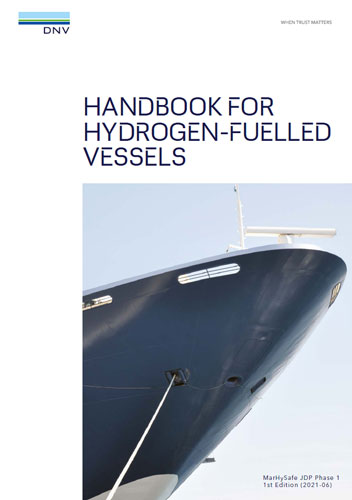Сб с 10 до 16
Handbook for Hydrogen-fuelled Vessels/Руководство для судов, работающих на водороде
Издание на английском языке
This Handbook is an important contribution on the path to its safe and efficient introduction, as well as the use of hydrogen as marine fuel. The information in it will provide guidance on how to deal with the current safety and regulatory barriers.
The Handbook is a product of the Maritime Hydrogen Safety (MarHySafe) Joint Development Project (JDP) and developed by DNV in collaboration with all the partners and observers in Phase 1, with input from the Norwegian Kolbjоrn Berge Leader of the Steering Committee MarHySafe JDP Norwegian Maritime Authority Maritime Authority. The Handbook provides a basis for a roadmap to hydrogen safety for the maritime industry, based on the current risk-based Alternative Design approval framework.
MarHySafe is a collaborative project involving the private business community as well as public authorities, and aims to support an increased uptake of hydrogen as an environmentally friendly solution for ships.
Contents
1 Summary
1.1 MarHySafe partners and observers
1.2 Disclaimer
2 Definitions and abbreviations
3 Introduction
3.1 Background
3.2 Study scope and limitations
Part A - Introduction to use of hydrogen in maritime
4 Introduction to maritime hydrogen systems
4.1 Safety-related properties
4.2 Generic hydrogen system configuration
5 Maritime hydrogen implementation phases
5.1 Feasibility
5.2 Outline specification
5.3 Design and procurement
5.4 Fabrication and testing
5.5 Installation and commissioning
5.6 Operation and maintenance
5.7 Maintenance
Part B – Regulations, codes, and standards for hydrogen as maritime fuel
6 the regulatory framework
6.1 The IGF Code
6.2 The Alternative Design approval process
6.3 Proof of equivalence and risk criteria
6.4 Class rules and the role of the Classification society
6.5 International hydrogen standards
6.6 Energy conversion – Fuel Cells
6.7 Hydrogen storage onboard
6.8 Safety distances and hazardous zones
6.9 Bunkering
7 Engineering details for hydrogen systems
7.1 Planning and design of LH2 and CH2 installations
7.2 Materials and welding
7.3 Pipe systems for LH2 and CH2 service
Part C – Hydrogen safety in maritime context
8 Risk assessment
8.1 Compliance-based versus risk-based approach
8.2 Risk assessment approaches
8.3 Risk-based design in a maritime setting
8.4 External risks
8.5 Methodologies for quantitative risk assessment
9 Possible risk mitigation/control measures
9.1 Safe design
9.2 Detection and alarms
9.3 Ignition control
9.4 Isolation and shutdown
9.5 Vents and pressure-relief systems / masts
9.6 Ventilation
9.7 Storage system leak control
9.8 Fire control and fire protection
10 Bunkering
11 Knowledge gaps and input to phase 2 priorities
11.1 Current knowledge gaps and suggested Phase 2 activities
11.2 Phase 2 – Pre calculate risk assessments to develop standards
12 References
Appendix A Learning from previous accidents
Appendix B Approval process – Design and analysis documentation for preliminary approval
Appendix C Methodology for Quantitative Risk Assessments




